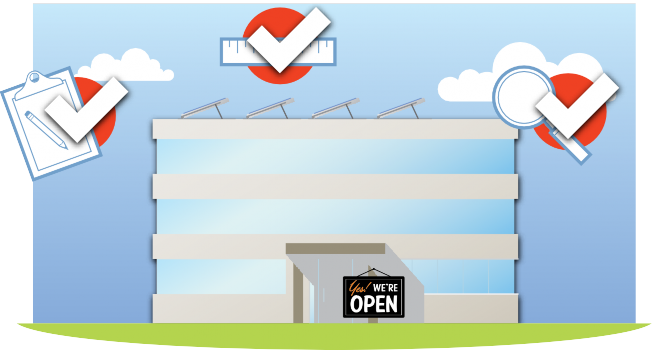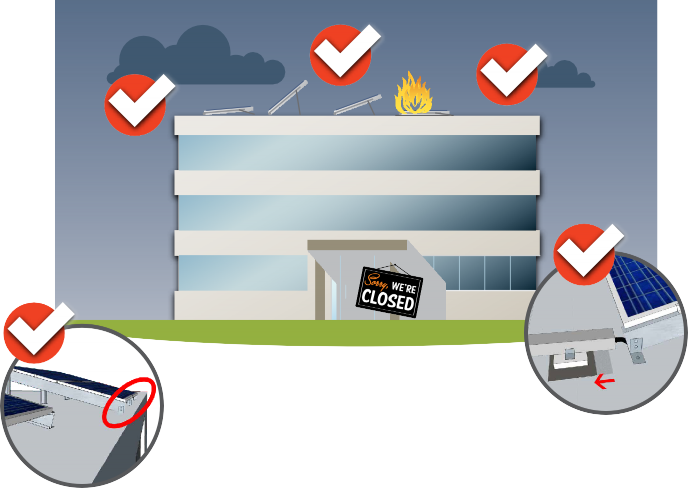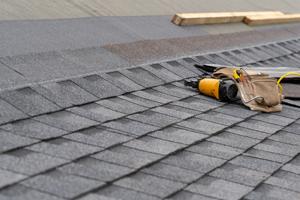Inspection checklist for photovoltaic (PV) arrays on commercial roofs
IBHS research has shown that ballasted PV systems may be subjected to sliding or localized lifting at wind speeds well below design levels. When a PV array is first installed, a baseline inspection should be conducted and the location of key elements should be clearly identified. Be sure to discuss liability, maintenance, and repair responsibilities with your PV installer and insurance company.
Following a strong wind event — with wind speeds of about 70 mph or higher — steps should be taken to identify and address any change or damage that may have occurred.
Initial inspection
After installation, create a baseline of the PV system and roof cover:
- Record distance between PV system and other roof-mounted equipment.
- Document locations of PV array, panels, and ballast.
- Inspect and photograph PV system and roof cover.
Post-event inspection and repairs
After a strong wind event, inspect and address the following:
- Loose or disconnected conduit, wiring, or electrical connections.
- Damage to roof cover, including tears and abrasion.
- Damage to PV arrays, including panels, connectors, and ballast.
- Movement of PV system and components, particularly changes in proximity to other roof-mounted equipment to determine if collision has or could occur.
- Overly tight cables and any signs of fraying or damage to cables or conduit, which could result in an electrical short or broken connection.
- PV systems and components can shift after a severe weather event, including systems suddenly or gradually moving toward the roof edge, as shown above.
- Other components that can shift after severe weather include the electrical tray, conduit, and mounting block with roof cover sheet carrying the power line, which is shown shifted away from the PV system. This may cause tightening or disconnection of the cable, which can be a fire hazard.
This material is provided for informational purposes only and does not provide any coverage or guarantee loss prevention. The examples in this material are provided as hypothetical and for illustration purposes only. The Hanover Insurance Company and its affiliates and subsidiaries (“The Hanover”) specifically disclaim any warranty or representation that acceptance of any recommendations contained herein will make any premises, or operation safe or in compliance with any law or regulation. By providing this information to you. The Hanover does not assume (and specifically disclaims) any duty, undertaking or responsibility to you. The decision to accept or implement any recommendation(s) or advice contained in this material must be made by you.
171-10003 (4/16) LC 2016-089
Related resources
Inspection checklist for photovoltaic (PV) arrays on commercial roofs
IBHS research has shown that ballasted PV systems may be subjected to sliding or localized lifting at wind speeds well below design levels. When a PV array is first installed, a baseline inspection should be conducted and the location of key elements should be clearly identified. Be sure to discuss liability, maintenance, and repair responsibilities with your PV installer and insurance company.
Following a strong wind event — with wind speeds of about 70 mph or higher — steps should be taken to identify and address any change or damage that may have occurred.
Initial inspection
After installation, create a baseline of the PV system and roof cover:
- Record distance between PV system and other roof-mounted equipment.
- Document locations of PV array, panels, and ballast.
- Inspect and photograph PV system and roof cover.
Post-event inspection and repairs
After a strong wind event, inspect and address the following:
- Loose or disconnected conduit, wiring, or electrical connections.
- Damage to roof cover, including tears and abrasion.
- Damage to PV arrays, including panels, connectors, and ballast.
- Movement of PV system and components, particularly changes in proximity to other roof-mounted equipment to determine if collision has or could occur.
- Overly tight cables and any signs of fraying or damage to cables or conduit, which could result in an electrical short or broken connection.
- PV systems and components can shift after a severe weather event, including systems suddenly or gradually moving toward the roof edge, as shown above.
- Other components that can shift after severe weather include the electrical tray, conduit, and mounting block with roof cover sheet carrying the power line, which is shown shifted away from the PV system. This may cause tightening or disconnection of the cable, which can be a fire hazard.
This material is provided for informational purposes only and does not provide any coverage or guarantee loss prevention. The examples in this material are provided as hypothetical and for illustration purposes only. The Hanover Insurance Company and its affiliates and subsidiaries (“The Hanover”) specifically disclaim any warranty or representation that acceptance of any recommendations contained herein will make any premises, or operation safe or in compliance with any law or regulation. By providing this information to you. The Hanover does not assume (and specifically disclaims) any duty, undertaking or responsibility to you. The decision to accept or implement any recommendation(s) or advice contained in this material must be made by you.
171-10003 (4/16) LC 2016-089
Related resources
Inspection checklist for photovoltaic (PV) arrays on commercial roofs
IBHS research has shown that ballasted PV systems may be subjected to sliding or localized lifting at wind speeds well below design levels. When a PV array is first installed, a baseline inspection should be conducted and the location of key elements should be clearly identified. Be sure to discuss liability, maintenance, and repair responsibilities with your PV installer and insurance company.
Following a strong wind event — with wind speeds of about 70 mph or higher — steps should be taken to identify and address any change or damage that may have occurred.
Initial inspection
After installation, create a baseline of the PV system and roof cover:
- Record distance between PV system and other roof-mounted equipment.
- Document locations of PV array, panels, and ballast.
- Inspect and photograph PV system and roof cover.
Post-event inspection and repairs
After a strong wind event, inspect and address the following:
- Loose or disconnected conduit, wiring, or electrical connections.
- Damage to roof cover, including tears and abrasion.
- Damage to PV arrays, including panels, connectors, and ballast.
- Movement of PV system and components, particularly changes in proximity to other roof-mounted equipment to determine if collision has or could occur.
- Overly tight cables and any signs of fraying or damage to cables or conduit, which could result in an electrical short or broken connection.
- PV systems and components can shift after a severe weather event, including systems suddenly or gradually moving toward the roof edge, as shown above.
- Other components that can shift after severe weather include the electrical tray, conduit, and mounting block with roof cover sheet carrying the power line, which is shown shifted away from the PV system. This may cause tightening or disconnection of the cable, which can be a fire hazard.
This material is provided for informational purposes only and does not provide any coverage or guarantee loss prevention. The examples in this material are provided as hypothetical and for illustration purposes only. The Hanover Insurance Company and its affiliates and subsidiaries (“The Hanover”) specifically disclaim any warranty or representation that acceptance of any recommendations contained herein will make any premises, or operation safe or in compliance with any law or regulation. By providing this information to you. The Hanover does not assume (and specifically disclaims) any duty, undertaking or responsibility to you. The decision to accept or implement any recommendation(s) or advice contained in this material must be made by you.
171-10003 (4/16) LC 2016-089
Related resources
Inspection checklist for photovoltaic (PV) arrays on commercial roofs
IBHS research has shown that ballasted PV systems may be subjected to sliding or localized lifting at wind speeds well below design levels. When a PV array is first installed, a baseline inspection should be conducted and the location of key elements should be clearly identified. Be sure to discuss liability, maintenance, and repair responsibilities with your PV installer and insurance company.
Following a strong wind event — with wind speeds of about 70 mph or higher — steps should be taken to identify and address any change or damage that may have occurred.
Initial inspection
After installation, create a baseline of the PV system and roof cover:
- Record distance between PV system and other roof-mounted equipment.
- Document locations of PV array, panels, and ballast.
- Inspect and photograph PV system and roof cover.
Post-event inspection and repairs
After a strong wind event, inspect and address the following:
- Loose or disconnected conduit, wiring, or electrical connections.
- Damage to roof cover, including tears and abrasion.
- Damage to PV arrays, including panels, connectors, and ballast.
- Movement of PV system and components, particularly changes in proximity to other roof-mounted equipment to determine if collision has or could occur.
- Overly tight cables and any signs of fraying or damage to cables or conduit, which could result in an electrical short or broken connection.
- PV systems and components can shift after a severe weather event, including systems suddenly or gradually moving toward the roof edge, as shown above.
- Other components that can shift after severe weather include the electrical tray, conduit, and mounting block with roof cover sheet carrying the power line, which is shown shifted away from the PV system. This may cause tightening or disconnection of the cable, which can be a fire hazard.
This material is provided for informational purposes only and does not provide any coverage or guarantee loss prevention. The examples in this material are provided as hypothetical and for illustration purposes only. The Hanover Insurance Company and its affiliates and subsidiaries (“The Hanover”) specifically disclaim any warranty or representation that acceptance of any recommendations contained herein will make any premises, or operation safe or in compliance with any law or regulation. By providing this information to you. The Hanover does not assume (and specifically disclaims) any duty, undertaking or responsibility to you. The decision to accept or implement any recommendation(s) or advice contained in this material must be made by you.
171-10003 (4/16) LC 2016-089








